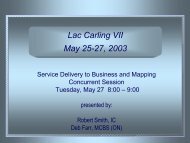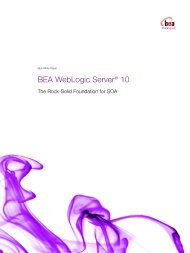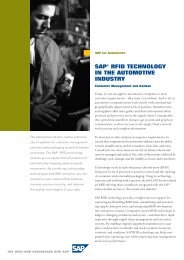The hidden costs of data migration. - IT World Canada
The hidden costs of data migration. - IT World Canada
The hidden costs of data migration. - IT World Canada
- No tags were found...
You also want an ePaper? Increase the reach of your titles
YUMPU automatically turns print PDFs into web optimized ePapers that Google loves.
IBM Global Technology ServicesNovember 2008<strong>The</strong> <strong>hidden</strong> <strong>costs</strong> <strong>of</strong> <strong>data</strong> <strong>migration</strong>.Strategies for reducing <strong>costs</strong> and quickly achievingreturn on investment
<strong>The</strong> <strong>hidden</strong> <strong>costs</strong> <strong>of</strong> <strong>data</strong> <strong>migration</strong>.Page 2Contents2 Executive summary3 Introduction5 What is driving <strong>data</strong> <strong>migration</strong>?5 Data <strong>migration</strong> challenges6 Hidden <strong>costs</strong> <strong>of</strong> <strong>migration</strong>7 S<strong>of</strong>tek <strong>data</strong> mobility solutions10 <strong>The</strong> bottom lineExecutive summary<strong>The</strong>re are many challenges associated with <strong>data</strong> <strong>migration</strong>. First, the amount <strong>of</strong><strong>data</strong> to be migrated is increasing as quickly as storage capacity grows. Second,<strong>data</strong> <strong>migration</strong> is problematic for most users. Next, applications need 24x7 <strong>data</strong>availability, so that <strong>IT</strong> departments have only narrow downtime windows foressential system maintenance and don’t want to “waste” this time migrating <strong>data</strong>.Data centers usually support multiple operating systems—mainframe, UNIX,Micros<strong>of</strong>t ® Windows ® and Linux ® technology—with the mix being determinedby the specifc applications in use. Finally, there usually is hardware from morethan one storage vendor in the <strong>data</strong> center—further increasing complexity.®<strong>The</strong> organization thinking about <strong>data</strong> <strong>migration</strong> should consider the followingkey factors—and how the S<strong>of</strong>tek <strong>data</strong> <strong>migration</strong> products can help:Key factors Description S<strong>of</strong>tek <strong>data</strong> <strong>migration</strong> s<strong>of</strong>twareScalabilityApplication availabilityApplicationperformanceVendor independenceHeterogeneousoperating system (OS)and storage supportStorage capacity continues togrow at a rate <strong>of</strong> 50 percentannually as <strong>migration</strong> needsincrease each year with morestorage coming <strong>of</strong>f <strong>of</strong> lease.Data availability requirementshave increased with24x7 applications such ase-mail and online commerce.Performance measurementsmust take into considerationhow quickly <strong>data</strong> is copiedfrom the source to targetand balanced againstnetwork bandwidth andsystem overhead.Multiple storage vendorshave unique requirementsfor <strong>migration</strong> and different<strong>migration</strong> techniques, addingcomplexity to the process.Multiple operating systemsand storage arrays add tocomplexity in the <strong>data</strong> center.Can scale <strong>migration</strong>s from movinga single volume to migratingterabytes <strong>of</strong> <strong>data</strong> to new, largerstorage locally or globallyHelps keep businesses runningbecause applications stay onlinewhile volumes are relabeled andinput/output (I/O) is transferred duringpatent-pending Dynamic SwapHelps ensure applicationperformance with dynamicthrottling/tuningHelps lower storage <strong>costs</strong> withS<strong>of</strong>tek’s simple, comprehensiveand proven methodology to assess,plan and validate <strong>migration</strong>sSupports all operating systems andmulti-storage array environments
<strong>The</strong> <strong>hidden</strong> <strong>costs</strong> <strong>of</strong> <strong>data</strong> <strong>migration</strong>.Page 3HighlightsOvertime work and lease overlapare <strong>hidden</strong> <strong>costs</strong> <strong>of</strong> <strong>data</strong> <strong>migration</strong>.IntroductionIn March 2005, S<strong>of</strong>tek surveyed 700 end users on how <strong>data</strong> <strong>migration</strong> impactstheir organizations. <strong>The</strong> results <strong>of</strong> the survey—carried out in conjunction witha leading industry analyst frm, Enterprise Strategy Group—show the full range<strong>of</strong> challenges such as unexpected downtime and cost overruns that users facein migrating <strong>data</strong>. <strong>The</strong> study found that many <strong>of</strong> these cost overruns remain“<strong>hidden</strong>,” because they involve overtime work and lease overlap. In addition, itfound that even though tools are available to help users address their <strong>migration</strong>challenges, many <strong>IT</strong> managers are either not aware <strong>of</strong> these tools or have not yetimplemented them. Exposing <strong>hidden</strong> <strong>costs</strong> <strong>of</strong> <strong>data</strong> <strong>migration</strong> and providing solu -tions to address them will help <strong>IT</strong> managers provide nonstop <strong>data</strong> <strong>migration</strong>smore effectively and efficiently.When you add them up, <strong>hidden</strong><strong>data</strong> <strong>migration</strong> <strong>costs</strong> can exceedthe cost <strong>of</strong> <strong>data</strong> <strong>migration</strong> tools.Users cite cost as one <strong>of</strong> the key factors keeping them from implementing new<strong>data</strong> <strong>migration</strong> tools. <strong>The</strong>y believe that, along with the actual purchase price <strong>of</strong>new technology, related <strong>costs</strong>—such as training, installation and pr<strong>of</strong>essionalservices—can add up to an expensive bundle. However, they typically overlookthe fact that the <strong>hidden</strong> <strong>costs</strong> <strong>of</strong> maintaining the status quo can be even greaterthan implementing new technology.In this paper, S<strong>of</strong>tek looks at the <strong>hidden</strong> <strong>costs</strong> <strong>of</strong> <strong>data</strong> <strong>migration</strong> that wererevealed by the survey, including <strong>costs</strong> resulting from:• Unplanned downtime• Delaying the purchase <strong>of</strong> new, better storage• Lease overruns• Overpaying for capacity• <strong>The</strong> need for additional storage hardware• Exceeding planned staff time• Exceeding <strong>data</strong> <strong>migration</strong> budget• Exceeding scheduled downtime• Lack <strong>of</strong> validation procedures to ensure <strong>data</strong> integrity.
<strong>The</strong> <strong>hidden</strong> <strong>costs</strong> <strong>of</strong> <strong>data</strong> <strong>migration</strong>.Page 4HighlightsAs storage capacity continues togrow exponentially, it’s importantto reevaluate the advantages and<strong>costs</strong> <strong>of</strong> <strong>data</strong> <strong>migration</strong> tools.With storage capacity continuing to grow at a rate <strong>of</strong> 50 percent annually, <strong>data</strong><strong>migration</strong> is a fact <strong>of</strong> life for the <strong>IT</strong> manager. Evaluating the <strong>costs</strong> and <strong>hidden</strong><strong>costs</strong> <strong>of</strong> <strong>migration</strong>s, along with new <strong>migration</strong> tools, can provide a new perspectiveon how to approach moving <strong>data</strong>.This paper demonstrates how to do the following:• Provide a simple, unified approach to <strong>data</strong> mobility by moving <strong>data</strong>:- Across virtually all operating systems, and storage vendors/platforms- At almost all volume, block and file (<strong>data</strong>set) levels- Using a common management console- Locally or over distance• Reduce the cost, complexity and risk <strong>of</strong> moving <strong>data</strong> with:- Nondisruptive storage/server replacement and consolidation designed totake full advantage <strong>of</strong> high-performance arrays with no lease overlaps- Tiered storage and workload balancing that minimizes outages- Nonstop distance replication with automated restore- A proven methodology for nonstop <strong>data</strong> mobility- Easy installation and use,with no additional hardware/s<strong>of</strong>tware• Ensure continuous application availability through:- Nondisruptive <strong>data</strong> movement,so applications remain online- Patent-pending Dynamic Swap technology- Dynamic performance throttling
<strong>The</strong> <strong>hidden</strong> <strong>costs</strong> <strong>of</strong> <strong>data</strong> <strong>migration</strong>.Page 5Highlights<strong>The</strong> key driver <strong>of</strong> <strong>data</strong> <strong>migration</strong> istechnology refresh.What is driving <strong>data</strong> <strong>migration</strong>?According to S<strong>of</strong>tek’s survey, technology refresh—replacing an array or serverwith a new one — is the number-one driver <strong>of</strong> <strong>data</strong> <strong>migration</strong>, followed byconsolidation and relocation. <strong>The</strong> storage hardware and server replacementinvolved in technology refresh, coupled with the expiration <strong>of</strong> storage equip -ment leases, means that storage managers have to move <strong>data</strong> on a regular basis.In addition, storage and server capacity are acquired at a rate typically rangingfrom 25 to 50 percent annually to accommodate <strong>data</strong> and application growth. So,every year—or even more <strong>of</strong>ten—a typical organization acquires storage technol -ogy to replace arrays on which lease or maintenance agreements are expiring,and it acquires additional capacity to accommodate anticipated growth.With the explosive growth <strong>of</strong> storage and with older storage coming <strong>of</strong>f <strong>of</strong>lease, the need for <strong>data</strong> <strong>migration</strong> is ever increasing. Additionally, applicationssuch as e-mail and online banking run 24x7, meaning increased requirementsfor <strong>data</strong> availability, even during <strong>data</strong> <strong>migration</strong>s.Increasing requirements for 24x7<strong>data</strong> availability mean less tolerancefor application downtown.Data <strong>migration</strong> challengesOne <strong>of</strong> the main issues that emerged from S<strong>of</strong>tek’s user survey is that applica -tion downtime is the biggest overall challenge to <strong>data</strong> <strong>migration</strong>. As a resultthe majority <strong>of</strong> <strong>migration</strong>s are conducted on weekends.<strong>The</strong> survey also found that while <strong>migration</strong>s are routine, they can be riskyevents, with 83 percent <strong>of</strong> <strong>migration</strong>s experiencing problems. Unexpecteddowntime was cited as the leading problem. Other problems include technicalcompatibility issues, <strong>data</strong> corruption, application performance issues and<strong>data</strong> loss.
<strong>The</strong> <strong>hidden</strong> <strong>costs</strong> <strong>of</strong> <strong>data</strong> <strong>migration</strong>.Page 6HighlightsTo minimize risk, most organizationsconduct <strong>migration</strong>s on weekends—which leads to costly overtime.In addition, users talked about how migrating <strong>data</strong> can be a complex process, withmost <strong>migration</strong>s taking more than two weeks to plan and involving fve peopleto implement. Add to this the composition <strong>of</strong> the typical <strong>data</strong> center—where -multiple operating systems and multiple storage vendors increase the complexity.Attesting to the fact that <strong>data</strong> <strong>migration</strong> is a fact <strong>of</strong> life for the <strong>IT</strong> manager,39 percent <strong>of</strong> those surveyed said that they perform <strong>migration</strong> on a weekly ormonthly basis. But with the downtime problems, the majority conduct their<strong>migration</strong>s on weekends to avoid overall risk. So, weekend <strong>migration</strong>s meancostly overtime. Because many companies lack suffcient numbers <strong>of</strong> <strong>IT</strong> staff,weekend <strong>migration</strong>s also can result in unhappy employees.<strong>The</strong>re is no getting around the fact that <strong>data</strong> <strong>migration</strong>s are diffcult, but theyhave to be done. <strong>IT</strong> managers do their best to plan the most effcient <strong>migration</strong>,estimating the best time to take applications down, how many peoplethey will need, and how much it will cost. But the survey found that the plan<strong>of</strong>ten goes awry.Since the cost <strong>of</strong> downtime can bemillions <strong>of</strong> dollars per hour, <strong>migration</strong>can impact the bottom line.Hidden <strong>costs</strong> <strong>of</strong> <strong>migration</strong>Considering that the cost <strong>of</strong> downtime can be up to millions <strong>of</strong> dollars per hour,migrating <strong>data</strong> can have a significant impact on an organization’s bottom line.Though <strong>data</strong> <strong>migration</strong> is conducted during planned downtime, the processseldom works out as planned. <strong>The</strong> best solution would be to eliminate the needfor downtime and conduct <strong>data</strong> <strong>migration</strong>s when applications are running.Delaying storage purchases as a way to avoid the risks or problems <strong>of</strong> moving<strong>data</strong> is also costly. Organizations can overpay for capacity, lease or mainte -nance overlap. And as long as they are using their old equipment, they won’tbe able to access cost-effciencies that new storage hardware can provide.
<strong>The</strong> <strong>hidden</strong> <strong>costs</strong> <strong>of</strong> <strong>data</strong> <strong>migration</strong>.Page 7HighlightsMost organizations rely on userfeedback to determine the success<strong>of</strong> their <strong>data</strong> <strong>migration</strong>s.Most survey participants said they rely on their end users to validate whethertheir <strong>data</strong> <strong>migration</strong> has been successful or not. Without validation procedures,problems show up when the business is running. <strong>The</strong> result can be downtimeduring working hours that the weekend <strong>data</strong> move was intended to avoid.From the discussion above, it is clear that users face very real issues in <strong>IT</strong>environments where the need for storage grows rapidly and downtime is notan option. Depending on the business and the amount <strong>of</strong> <strong>data</strong> being moved,there is no question that online <strong>data</strong> <strong>migration</strong> solutions that do not requireapplication downtime can help reduce the <strong>hidden</strong> <strong>costs</strong> <strong>of</strong> <strong>data</strong> <strong>migration</strong>,including its significant administrative <strong>costs</strong>. Online solutions can take therisk out <strong>of</strong> moving <strong>data</strong> by eliminating downtime, streamlining the <strong>migration</strong>process and ensuring <strong>data</strong> integrity.Data mobility solutions canreduce the cost, complexity andrisk involved in moving <strong>data</strong>.S<strong>of</strong>tek <strong>data</strong> mobility solutionsIBM Nonstop Data Mobility s<strong>of</strong>tware provides a simple and unified approachdesigned to move live <strong>data</strong> over any distance, regardless <strong>of</strong> server platform or -storage vendor. S<strong>of</strong>tek’s Nonstop solutions can reduce the cost, complexity and risk <strong>of</strong>moving <strong>data</strong>, thereby increasing application availability and customer choice.Since 1996, S<strong>of</strong>tek has set the industry standard for <strong>data</strong> <strong>migration</strong>, movingterabytes <strong>of</strong> <strong>data</strong> for more than 60 percent <strong>of</strong> Fortune 1000 companies. S<strong>of</strong>tekcan meet the key requirements and provide benefits in virtually all <strong>data</strong><strong>migration</strong> scenarios:• Technology refresh —S<strong>of</strong>tek solutions can eliminate lease or maintenanceoverlap charges; they can enable <strong>data</strong> <strong>migration</strong> across array platformsand can assure <strong>data</strong> integrity during the process.• Consolidation — S<strong>of</strong>tek solutions enable <strong>IT</strong> organizations to easily reconfigurevolumes or logical unit number (LUN) sizes, use an automated andrepeatable process and perform the <strong>migration</strong> with minimal downtime.
<strong>The</strong> <strong>hidden</strong> <strong>costs</strong> <strong>of</strong> <strong>data</strong> <strong>migration</strong>.Page 8HighlightsS<strong>of</strong>tek <strong>data</strong> <strong>migration</strong> productscan help with a variety <strong>of</strong> issuesrelated to distance, availabilityand performance.• Relocation—S<strong>of</strong>tek solutions can help bring systems back online quickly,minimizing revenue impact and avoiding <strong>data</strong> loss or corruption.• Improvements to application performance—S<strong>of</strong>tek solutions provide workloadbalancing, tiered storage and the ability to perform maintenanceduring business hours.S<strong>of</strong>tek’s <strong>data</strong> <strong>migration</strong> products provide solutions to a full range <strong>of</strong><strong>migration</strong> needs, including:• Migration over any distance—Data can migrate from and to almost anylocation, locally or globally.• Application availability —Applications can continue running during the<strong>migration</strong>; volumes are relabeled and I/O is transferred using DynamicSwap.• Application performance — Dynamic throttling/tuning ensuresapplication performance.• Assessment, planning and validation—S<strong>of</strong>tek solutions and processes arebased on proven methodologies.• Open, heterogeneous storage support—S<strong>of</strong>tek solutions enable moving <strong>data</strong>in multi-storage array environments, to any storage architecture and onvirtually all major operating systems and platforms.TDMF s<strong>of</strong>tware—setting the standard in <strong>data</strong> <strong>migration</strong><strong>The</strong> cornerstone to S<strong>of</strong>tek’s enterprise <strong>data</strong> <strong>migration</strong> s<strong>of</strong>tware <strong>of</strong>ferings is theS<strong>of</strong>tek Transparent Data Migration Facility (TDMF ) family <strong>of</strong> products. Forthe past ten years, the TDMF name has become synonymous with nondisruptive
<strong>The</strong> <strong>hidden</strong> <strong>costs</strong> <strong>of</strong> <strong>data</strong> <strong>migration</strong>.Page 9HighlightsNow considered the gold standard,TDMF technology enables organizationsto move <strong>data</strong> withoutinterrupting applications.<strong>data</strong> <strong>migration</strong> in multivendor storage environments. Today, TDMF technologyis recognized as the de-facto “gold-standard” in heterogeneous, host-baseds<strong>of</strong>tware for performing online <strong>migration</strong>s in enterprise environments.TDMF s<strong>of</strong>tware enables <strong>IT</strong> organizations to move <strong>data</strong> at the volume or blocklevel between different storage vendors or versions—with no interruption to theapplications running the business. <strong>The</strong> TDMF solution provides local or global<strong>data</strong> <strong>migration</strong> for technology refresh, consolidation, relocation and performanceimprovement.®<strong>The</strong> TDMF product suite currently supports IBM z/O S ,UNIX, Micros<strong>of</strong>tWindows, and Linux environments.With zDMF technology, organi -zations can easily upgrade andconsolidate storage and fine-tuneperformance on the fly.zDMF s<strong>of</strong>tware—the solution for mainframe <strong>data</strong>set <strong>migration</strong>Building on its enterprise <strong>data</strong> <strong>migration</strong> heritage, S<strong>of</strong>tek also <strong>of</strong>fers S<strong>of</strong>tekzOS Data Migration Facility (zDMF), the industry’s first product for mainframe<strong>data</strong>set-level <strong>migration</strong>. zDMF technology is architected from the groundup to nondisruptively migrate mainframe <strong>data</strong>sets. This ability provides a longsought-afterway to easily upgrade and consolidate storage, provide on-the-fyperformance tuning and deliver tiered storage.<strong>The</strong> bottom line<strong>The</strong> bottom line is that S<strong>of</strong>tek’s products and expertise help <strong>IT</strong> organizations toavoid “wasted time” in moving <strong>data</strong>. More important, organizations can quicklyimprove the return on investment (ROI) <strong>of</strong> their storage systems by keepingapplications running, eliminating lease overlap <strong>costs</strong> and avoiding budget overruns.
<strong>The</strong> <strong>hidden</strong> <strong>costs</strong> <strong>of</strong> <strong>data</strong> <strong>migration</strong>.Page 10HighlightsFollowing is an example <strong>of</strong> how one large company was able to leverage itsinvestment in S<strong>of</strong>tek technology to achieve ROI and overcome the <strong>hidden</strong> <strong>costs</strong><strong>of</strong> the status quo.Before implementing the S<strong>of</strong>tek solution, the company experienced the following:• This international media conglomerate migrated 75TB <strong>of</strong> <strong>data</strong> ninetimes per year.• When performing these <strong>migration</strong>s, the company experienced 90 minutes<strong>of</strong> application outage per server, with an average <strong>of</strong> 15 servers experiencingthe outage.• A conservative estimate <strong>of</strong> the planned downtime cost was US $ 2,500 per hour.• <strong>The</strong> average burdened hourly wage <strong>of</strong> staff that performs <strong>migration</strong>swas US $51.By taking advantage <strong>of</strong> S<strong>of</strong>tektechnology, one company not onlysaved US$841,000 in lease extensions,but also reduced downtimeand staff effort by 66 percent.After implementing the S<strong>of</strong>tek solution:• By enabling <strong>migration</strong> onto newer volumes more quickly, S<strong>of</strong>tek’s TDMFsolution enabled the company to avoid lease extensions <strong>of</strong> US $841,000annually, based on an average <strong>of</strong>:- Overlapping capacity <strong>of</strong> 337TB- A monthly per-TB cost <strong>of</strong> US $555 overlap 1- Average overlap <strong>of</strong> four and a half months• S<strong>of</strong>tek TDMF technology reduced downtime and staff effort by 66 percent.
<strong>The</strong> <strong>hidden</strong> <strong>costs</strong> <strong>of</strong> <strong>data</strong> <strong>migration</strong>.Page 11HighlightsBased on the assumptions outlined above, the estimated two-year financial impact<strong>of</strong> TDMF s<strong>of</strong>tware on operations <strong>of</strong> this company is outlined in the chart below.For this company, the S<strong>of</strong>tekpayback was a 53 percent ROIin just 27 months.Hidden <strong>costs</strong> versus S<strong>of</strong>tek solution (technology refresh example)Status quo Implementing S<strong>of</strong>tek SavingsCost <strong>of</strong> downtime US$1,012,500 US$334,125 US$678,375Cost <strong>of</strong> staff(specifc to <strong>migration</strong>)Cost <strong>of</strong> overlappingleasesUS$52,908 US$17,571 US$35,337US$1,683,315 0 US$1,683,315TOTAL US$2,748,723 US$351,696 US$2,397,027Savings summaryHidden <strong>costs</strong>Investment in S<strong>of</strong>tek s<strong>of</strong>tware, services,and maintenance over two yearsNet savingsUS$2,397,027US$1,375,000US$1,022,027ROI53 percentPayback timeCost <strong>of</strong> NOT investing in Nonstop DataMobility Solution27 monthsUS$99,876/month(after payback period ends)This example shows that Nonstop Data Mobility Solutions can achievefaster ROI by:• Keeping applications running all the time• Decreasing unexpected downtime• Reducing staff <strong>costs</strong>• Implementing new storage today, not tomorrow• Eliminating lease overlaps.
In summary, the best solution is to conduct <strong>data</strong> <strong>migration</strong> whileapplications are running.For more informationTo learn more about how S<strong>of</strong>tek products can help you conduct <strong>data</strong><strong>migration</strong> while your applications are running, visit:ibm.com/services/storage© Copyright IBM Corporation 2008IBM Global ServicesRoute 100Somers, NY 10589U.S.A.Produced in the United States <strong>of</strong> AmericaNovember 2008All Rights ReservedIBM, the IBMlogo, ibm.com, MVS,Nonstop Data Mobility, S<strong>of</strong>tek,Transparent Data Migration Facility(TDMF), z/OS, and other referenced IBMproducts and services are trademarks <strong>of</strong>International Business MachinesCorporation in the United States, othercountries or both.Other company, product and servicenames may be trademarks or servicemarks <strong>of</strong> others.References in this publication to IBMproducts or services do not imply that IBMintends to make them available in allcountries in which IBM operates.SDD03010-USEN-1 Depreciation on 1TB <strong>of</strong> <strong>data</strong>, given a purchasecost per TB <strong>of</strong> US $20,000 (or US $0.02/MB) isUS $555 per TB per month, assuming a 36-monthuseful life for the hardware.GTW01279-USEN-01










